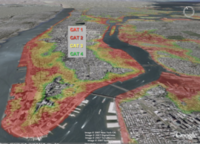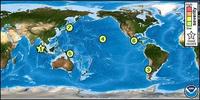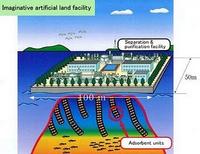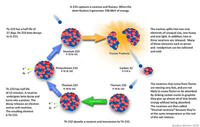-
Exploring solutions to growing water shortages
Most Americans do not pay much attention to how much water they use when they take a shower or when they water the grass, but Michael Sullivan, a global executive at IBM thinks this will change; “Water is a finite resource,” Sullivan told a panel in a conference on water policy; “What we’re dealing with is that there’s a finite supply, and as the population grows and industry grows, we’re stressing that finite supply”
-
-
New York unprepared for flooding, sea level rise

New York City may be a fast paced city of bright lights, sleek attitudes, fashion trends, and some of the best sports teams in the country, but underneath the glitz and glamour is a city which is not prepared for an act of God and which is being threatened by rising sea levels and severe storm flooding; “It’s a million small changes that need to happen,” one expert says
-
-
Seventy-four nuclear reactors in tsunami-risk areas
Researchers have, for the first time, identified those nuclear power plants which are more vulnerable to suffering the effects of a tsunami; in total, twenty-three plants, in which there are seventy-four active nuclear reactors, are located in dangerous areas in east and southeast of Asia
-
-
Seventy-four nuclear reactors in tsunami-risk areas

Researchers have, for the first time, identified those nuclear power plants which are more vulnerable to suffering the effects of a tsunami; in total, twenty-three plants, in which there are seventy-four active nuclear reactors, are located in dangerous areas in east and southeast of Asia
-
-
Thermoelectric material converts heat waste to electricity

Scientists have developed a thermoelectric material which they claim is the best in the world at converting waste heat to electricity; this is very good news, since nearly two-thirds of energy input is lost as waste heat
-
-
Limiting world trade unlikely to reduce CO2 emissions
The United States emits less CO2 in the production of its exports than is contained in its imports, simply because it imports more than it exports; only about 20 percent of CO2 transfers from China into the United States can be traced back to the fact that China is in effect relatively more specialized in the production of dirty goods; interventions in world trade, like CO2 tariffs, would probably have only a small impact on global emissions
-
-
Lessons learned: Cheech and Chong at the Y-12 security breach
On 28 July 2012, an 82-year old nun and her two confederates — both senior citizens themselves – breached the vaunted and supposedly impregnable perimeter protection system at the Y-12 National Security Complex at Oak Ridge, where uranium for nuclear weapons is processed and stored (the Y-12 complex is not affiliated with the Oak Ridge National Laboratory [ORNL]); a report on the incident by the Inspector General of the Department of Energy is couched in bureaucratic jargon, but it reveals that the Y-12 security system and practices were much worse than Cheech and Chong could have ever portrayed in their wildest stand-up comedy routines or loopy films
-
-
New law aims to make Istanbul earthquake-safe, but it has its critics

Estimates of Istanbul’s population range from twelve and nineteen million people, a significant increase from two million people fiftyyears ago; during the waves of migration to Istanbul during the 1960s,1970s, and 1980s, the government gave citizens free permitsto add to their homes, which resulted in single-story residents becoming 4-or 5-story buildings on unstable foundations; Istanbul sits only thirteen miles north of the North Anatolian Fault, the intersection of the Eurasian and Anatolian plates, and has been subject to devastating earthquakes; new, controversial law aims to make Istanbul’s buildings earthquake-safe
-
-
Microstructural improvements enhance material properties
DARPA merges structural engineering principles with new fabrication technologies to demonstrate microstructural control of materials at the micron level; the ultimate objective of the agency’s Materials with Controlled Microstructural Architecture (MCMA) program is to be able to develop materials in the future with properties tailored to meet specific mission requirements
-
-
U.S. models underestimates costs of carbon pollution
Model used by government all but ignores economic damages that climate change will inflict on future generations; two economists argue that when these costs are factored in, the real benefits of carbon reduction range from 2.6 to more than 12 times higher than the government’s estimate
-
-
Boeing to pursue cybersecurity opportunities in Japan
Boeing and Japanese trading company Sojitz are teaming up to offer advanced cybersecurity solutions in Japan to help protect critical government, civil, and commercial information technology infrastructure
-
-
Harvesting fuel for nuclear reactors from the sea

Uranium floats in Earth’s oceans in trace amounts of just 3 parts per billion. It is not much, but it adds up; combined, our oceans hold up to 4.5 billion tons of uranium — potentially enough to fuel the world’s nuclear power plants for 6,500 years; researchers propose ways to harvest this uranium
-
-
Dry-run experiments confirm key aspect of Sandia nuclear fusion concept

Magnetically imploded tubes called liners, intended to help produce controlled nuclear fusion at scientific “break-even” energies or better within the next few years, have functioned successfully in preliminary tests, according to researchers
-
-
Nexans shows its anti-theft cable solutions

Nexans is showing its new anti-theft cable solutions at InnoTrans, which opened yesterday in Berlin; the solution promises to help network operators reduce the high volume of copper cables theft along their railway networks
-
-
Thorium to play limited role in U.K. future power supply

Worldwide, there has for a long time been a sustained interest in the thorium fuel cycle and presently there are several major research initiatives which are either focused specifically on the thorium fuel cycle or on systems which use thorium as the fertile seed instead of U-238; the U.K. National Nuclear Laboratory examined the topic and concluded that thorium has theoretical advantages but that these benefits are often overstated; as a result, thorium fuel cycle at best has only limited relevance to the United Kingdom as a possible alternative plutonium disposition strategy and as a possible strategic option
-
More headlines
The long view
Water Wars: A Historic Agreement Between Mexico and US Is Ramping Up Border Tension
As climate change drives rising temperatures and changes in rainfall, Mexico and the US are in the middle of a conflict over water, putting an additional strain on their relationship. Partly due to constant droughts, Mexico has struggled to maintain its water deliveries for much of the last 25 years, deliveries to which it is obligated by a 1944 water-sharing agreement between the two countries.
Trump Is Fast-Tracking New Coal Mines — Even When They Don’t Make Economic Sense
In Appalachian Tennessee, mines shut down and couldn’t pay their debts. Now a new one is opening under the guise of an “energy emergency.”
Smaller Nuclear Reactors Spark Renewed Interest in a Once-Shunned Energy Source
In the past two years, half the states have taken action to promote nuclear power, from creating nuclear task forces to integrating nuclear into long-term energy plans.
Keeping the Lights on with Nuclear Waste: Radiochemistry Transforms Nuclear Waste into Strategic Materials
How UNLV radiochemistry is pioneering the future of energy in the Southwest by salvaging strategic materials from nuclear dumps –and making it safe.
Model Predicts Long-Term Effects of Nuclear Waste on Underground Disposal Systems
The simulations matched results from an underground lab experiment in Switzerland, suggesting modeling could be used to validate the safety of nuclear disposal sites.
